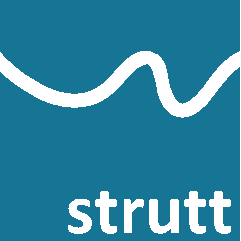
Strutt|Criteria|Ratings|Sound Insulation|Speech Privacy Predictor (SPP) calculates the Speech Privacy Predictor (SPP) and inserts it into the current row of the worksheet.
SPP is a predictive methodology for assessing speech privacy. It attempts to predict the level of dissatisfaction for a given subjective speech privacy criterion for open plan and enclosed office spaces.
The Strutt implementation of SPP is primarily based on Salter et al. (2003).
The SPP is calculated differently for open plan and enclosed spaces, accounting for the different source and isolation factors.
For open plan offices:
`SPP=L_("speech") + C_("privacy") - \Delta L_("dist") - \Delta L_("screen") - L_("BG")`
where:
`L_("speech")` is the voice source level in dB(A)
`C_("privacy")` is the Speech Privacy Criteria in dB(A). The mapping from subjective privacy requirement to numerical Speech Privacy Criteria is tabulated below
`\Delta L_("dist")` is the distance propagation attenuation
`\Delta L_("barrier")` is the screening attenuation provided by any barrier between source and receiver. Tabulated values used to calculate the screening correction are provided below
`L_("BG")` is the background noise level
For open plan areas, sound from the source workstation will attenuate as the distance between workstations increases. The table below provides values for this effect. Strutt interpolates the correction factors for distances in between values included in the table. Note that these values assume absorptive ceiling and workstation partitions and carpeted floors.
Distance from source workstation to receiver workstation (feet / metres) |
Criteria, dB(A) |
| 3 / 0.915 | +9 |
| 6 / 1.83 | +6 |
| 12 / 3.66 | +3 |
| 24 / 7.32 | 0 |
The barrier noise reduction correction accounts for the effectiveness of the partitions between workstations in blocking sound.
To calculate the effectiveness of partitions in an open plan, refer to the table below.
Note that this calculation assumes an absorptive ceiling (minimum NRC of .65), partition components with a minimum STC of 18,
and 50% of panels/wall surfaces above 3 feet having sound absorbing materials, such as bookcases with books or acoustical panels.
Strutt interpolates the values in the table based on source-receiver distance vs. barrier height.
For enclosed offices:
`SPP = L_("speech") + C_("privacy") + \Delta L_("source room") - STC_("partition") - \Delta L_("receiver room") - L_("BG")`
where:
`L_("speech")` is the voice source level in dB(A)
`C_("privacy")` is the Speech Privacy Criteria in dB(A)
`\Delta L_("source room")` is a correction to account for the source room effect
`\STC_("partition")` is the Sound Transmission Class (STC) rating of the partition between spaces
`\Delta L_("receiver room")` is a correction to account for the receiver room effect
`L_("BG")` is the background noise level
For predictions of `L_("speech")`, Salter et al present estimates of typical voice levels associated with the loudest likely behavior of employees in the workgroup occupying the space. Typical voice levels are given in the table below.
Voice Source Level |
Typical Activity |
Criteria, dB(A) |
| Low | Telephone conversation using a low voice level | 54 |
| Conversational | Casual conversation between two people in an office setting | 60 |
| Raised | Conversation of three or more people in a meeting | 66 |
| Loud | Talking into a speakerphone, delivering a presentation | 72 |
In private offices and conference spaces, voice levels in the source room are adjusted to account for the amount of absorption provided by the furnishings and room volume. These values are listed in the Table below. Absorptive surfaces include absorptive wall and ceiling materials, upholstered furniture, bookcases with books, and carpeting. Hard surfaces include gypsum board walls and/or ceilings, vinyl or concrete floors, unupholstered furniture, bare desks. Strutt interpolates the correction factors for floor areas in between values included in the table.
Floor Area (square feet / square metre) |
Criteria, room w/ 50% absorptive surfaces, dB(A) |
Criteria, room w/ <20% absorptive surfaces, dB(A) |
| 60 / 5.58 | +9 | +15 |
| 125 / 11.63 | +6 | +12 |
| 250 / 23.26 | +3 | +9 |
| 500 / 46.52 | 0 | +6 |
| 1000 / 93.03 | -3 | +3 |
The receive room will absorb some of the intruding sound radiating from the common wall. The table below shows the values accounting for this effect. Strutt interpolates the correction factors for ratios in between values included in the table.
Ratio Floor Area Receive Room to Common Partition Area |
Criteria, room w/ 50% absorptive surfaces, dB(A) |
Criteria, room w/ <20% absorptive surfaces, dB(A) |
| 1 | 0 | -5 |
| 1.5 | +2 | -3 |
| 2 | +3 | -2 |
| 3 | +5 | 0 |
| 4 | +6 | +1 |
| 5 | +7 | +2 |
| 6 | +8 | +3 |
| 10 | +10 | +5 |
Strutt uses the following mapping from subjective privacy requirement to numerical Speech Privacy Criteria (from Salter et al. (2003)):
Level of Speech Privacy |
Description |
`C_("privacy")` |
| Confidential | Speech from adjacent spaces is audible but not intelligible - the listener is aware that a conversation is occurring, but is not able to understand individual words | 15 |
| Normal | Speech from adjacent space is audible and partially intelligible - the listener has the ability to comprehend an occasional word but never full sentences | 9 |
| Marginal | Speech from adjacent spaces is largely understandable | 3 |
The user form adds the calculated level of Speech Privacy Acceptability to the selected row of the spreadsheet, as per the table below.
Sound Excess |
Level of Dissatisfaction |
| +3 | Mild |
| +7 | Moderate |
| +12 | Strong |
| >+20 | Extreme |
References:
Salter, CM and Powell, K and Begault, D and Alvarado, R (2003) Case Studies of a Method for Predicting Speech Privacy in the Contemporary Workplace